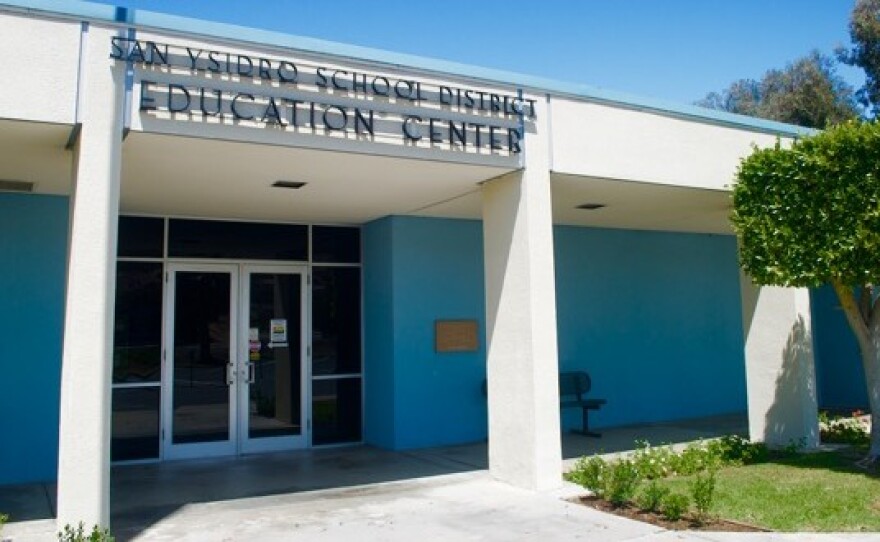The San Ysidro School District, which had been on the verge of a state takeover, has turned around its credit rating from near junk status a year ago to “A” ratings from two major rating agencies.
The rating boosts came less than a month after the district hired a new interim superintendent.
Edward Velasquez, San Ysidro’s current superintendent, said Moody’s rated the district “A1.” Standard & Poor’s also bumped the district up to an “A-” rating.
This ratings mean the agencies are confident the district has the money and financial stability to meet its bond obligations. The higher ratings allow the district to issue more bonds, or refinance the ones it has, more cheaply than it would otherwise.
Rodolfo Linares, a member of the district’s board of education, gives full marks to Velasquez, who had only been at the district for 29 days when he told the board the good news.
“What a difference a superintendent makes,” Linares said.
RELATED:
Path Santee School District Took To Expensive Capital Appreciation Bond
Today’s Debt Is Tomorrow’s Burden In Some School Districts
San Ysidro has been rocked with scandal and mismanagement for years, with one former superintendent being sentenced to jail in a 2013 pay-to-play scandal. Another corruption investigation resulted in the resignation last year of a school board trustee.
During much of the last couple of years the district had an appointed financial overseer from the San Diego County Office of Education because of doubts about the district’s ability to pay its bills. Those doubts about the district’s finances resulted in what’s known as a negative certification. If the district ran out of money, then the state would have taken over and given San Ysidro an emergency loan.
S&P had previously given San Ysidro a “BBB-” rating, which is considered just above a “junk bond” status. Moody’s “A1” rating is equivalent to an “A+” rating from S&P and represents “above average creditworthiness.”
Fitch Ratings, the third principal credit rating agency, gave San Ysidro’s general obligation bonds a “BB+” credit rating in May 2014. That’s considered a “junk bond” or speculative rating, meaning it’s likely a risky investment option for bond buyers. Fitch has not yet issued an updated evaluation for San Ysidro, although district staff has been working with the agency on a new rating.
Board President Antonio Martinez credited Velasquez, as well as the support from the board, for the improved rating.
“We’ve resolved two main lawsuits, we’re out of negative certification,” he said. “So I think when you look at everything combined it’s just a good, good story.”
Earlier this year the district settled a lawsuit with parents over the use of pesticides at Beyer Elementary. It also settled a lawsuit with a solar panel construction company over a breach of contract dispute.
The rating agencies seemed to agree with Martinez, at least in part. S&P cited the resolution of pending lawsuits among the reasons for the rating upgrade, as well as “good available reserves.”
Moody’s pointed to the district’s “sound financial position,” as well as a “new management team” for its bond rating.
San Ysidro has also moved out of negative certification, which the district received because the Office of Education believed the district didn’t have enough money to pay its bills. The district is currently under what’s known as a qualified certification, meaning the county is still not completely confident about the district’s finances.
“Now we can start focusing on what is the most important, which is our academics, curriculum, instruction, making sure our staff gets the support they need,” Martinez said. “Those are the things a school district should be focused on.”
During the board meeting April 16, when Velasquez told the board about the new ratings, he said the district likely can refinance some of its outstanding bonds. That could save taxpayers in the district $50 to $70 million, he estimated.
An inewsource investigation found San Ysidro had issued about $75 million in capital appreciation bonds between 2005 and 2012. Those bonds carry a total debt of more than $480 million.
A 2011 capital appreciation bond with a payout ratio of almost $15 for every dollar borrowed was the second most expensive bond in the county and the eighth most expensive in the state.
Given the upgraded credit rating, Linares hopes the district can not only refinance bonds but pay some off early. Taxpayers, he said, could save as much as $300 million if they “start making payments now, not leave those payments to my grandchildren.”





